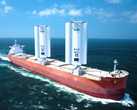It has long been known that the oceans absorb a huge proportion of our CO2 emissions. Phytoplankton, for example, are among the organisms that break down large parts of it back into oxygen and other organic compounds.
However, this only applies to part of the popular respiratory poison. The concentration of CO2 in the world's oceans is increasing and because water in combination with carbon dioxide turns into carbonic acid, the pH value drops: the water becomes acidic, causing corals to die, for example.
This is at least one reason why several projects are currently being launched to reduce the CO2 concentration in seawater. This makes the water less acidic and allows it to absorb more CO2 from the air. A double benefit.
There is a test facility in the port of Los Angeles, for example. There are also pilot projects in Norway and Singapore.

Of course, it is not easy to get CO2 out of the water. Electricity is needed to split the water into an acidic and an alkaline part. First, the acidic part is returned.
Now there is an over-concentration of CO2 so that it becomes gaseous and can be filtered. At the end of the process, the alkaline part of the water is returned. The seawater with a significantly healthier proportion of CO2 then flows back into the ocean. CO2 remains behind.
Sounds complicated, but it is much simpler than filtering CO2 from the air. Among other things, the concentration of CO2 in water is over a hundred times higher than in air. Facilitating the process should reduce the costs from up to €1,000 ($1,100) when extracting CO2 from the air to around €90 ($100) when extracting it from water.
This price is already below the current CO2 price of €114 ($125) in Sweden. In the EU, it is expected to be around €60 ($65) per ton by 2030. This means that the process could generate profits fairly quickly - and help the climate and the world's oceans. A triple win.
Carbonates are currently being produced to store CO2 in the process described. These are sometimes pretty-looking crystals that bind CO2 to magnesium or calcium, for example. The magnesite and calcite produced could then be stored.
A look at global emissions shows that even this can only make a small contribution to reducing CO2 emissions. These currently amount to around 40 billion tons per year. The largest plants currently in operation can filter up to 4,000 tons per year from seawater.
Even one million of these devices would only offset 10 percent. But at least it's a start.














